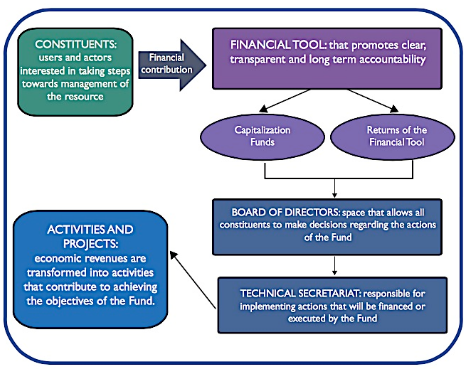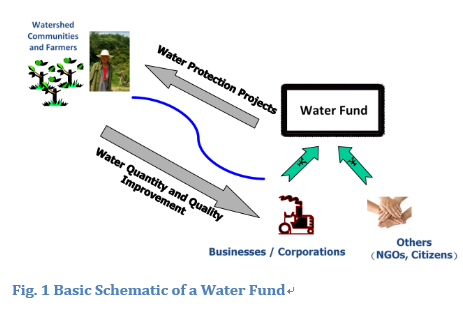
Financial Funds as an Instrument for Watershed Protection
Details
Watersheds play an ever-growing role in supplying good-quality and sufficient water to urban areas. This function of watersheds essentially depends on land and water use practices in the surrounding area. However, certain land use restrictions often put local livelihoods at stake which demands an integrated approach of sustainable watershed management (SWM). A SWM requires negotiations between parties from up- and downstream areas, where a wide range of different parties need to be included in order to both improve livelihoods and increase the provided ecosystem services of the watershed. Often land-uses need to be changed, alternative incomes must be found for local livelihoods, and the awareness must be raised. The challenge lies in how to incentivise such a SWM. Several institutional mechanisms appeared that should foster SWM and the protection of watershed services. Among those mechanisms is the idea of direct payments for upstream ecosystem services which led to the development of the concept of a ‘water fund’ as a new financial mechanism.
Fig. 1 Basic Schematic of a Water Fund
According to the USAD a water fund is defined as follows: “A Water Fund is a long-term financial mechanism that is stable, transparent and that allows different actors to join efforts to solve a common problem around integrated watershed management”. Water funds as an innovative financial tool promise environmental, social, and economic benefits. Water funds ensure continuous financial resources, which can be invested into activities that will protect, restore, and conserve watersheds and their water. They also act as a kind of platform for co-responsibility fostering dialogue and reuniting various actors involved in the watershed management. It gives a chance to local actors in participating more actively in the management of water resources, which will in return improve the decision-making process and enhance the implementation of certain policies and activities for water protection. Water funds also play a crucial role regarding providing technical assistance and monitoring the execution of activities. In the long run this will guarantee the water supply for many cities, especially mega-cities, and improve the development of livelihoods around watersheds.
Fig. 2 Fundamental Components of a Water Fund
The establishment of a water fund occurs in three phases: negotiation, foundation, and implementation phase. Water funds can act in different roles - as a funder for activities or as an executor or in both ways. In general, a water fund consists of several fundamental components, which include interested public and private actors, a financial tool, a board of directors, a technical secretariat, and certain activities or projects (see Figure 1). Interested actors give financial contribution to the fund, which are managed by the financial tool. The financial resources can be either utilized as capital assets or as revolving assets. The board of directors decides on consensus about activities that will be implemented. Those activities and projects are implemented by the technical secretariat. It is important to mention that a fund can also solely serve as a generator for financial means whereas the implementation will be carried out by other entities.
China Mega-City-Water-Fund (CMCW)
Following the example of the very first water fund “Fondo para la Protección del Agua” (FONAG), which was developed in Quito in 2000, the China Mega-City-Water-Fund (CMCW) was launched in August 2015 as a part of the China Biodiversity Conservation and Green Development Foundation (CBCGDF). It was founded by a group of stakeholders, including China Biodiversity Conservation and Green Development Foundation (CBCGDF), IUCN, Forest Trends, the Chinese Society of Soil and Water Conservation, Kieser & Associates LLC, and the Beijing Forestry Society (BFS), with the aim to improve the water quantity and quality as well as local livelihoods in the Miyun watershed and to strive for better collaboration in that area. This fund was developed within the framework of the Partnership for Mega-City Watersource Protection (PWMP), which serves as a worldwide information exchange platform for experiences and knowledge gained from pilot projects of the programme ‘Mega-cities and their Watersheds: Nature-based Solutions for Sustainable Drinking Water Sources’ (2013-2016).
The funding of the CMCW comes from the government, private actors, NGOs, and other international partners. Three different kinds of strategies are used: upstream, downstream, and fundamental operations. This water fund promises a cost-effective approach since a primarily investment evaluation process is applied as a first step.
Important Criteria for the Sustainability of a Water Fund
Certain mechanisms or characteristics have been detected that seem to be crucial for the sustainability of a water fund. For the fund it is essential to have adequate long-term financial resources and compliance mechanisms that ensure the funding of activities and projects serving the fund’s intention. Having diverse resources for financing makes the fund more sustainable and guarantees a continuous and constant availability of financial means. Efficient and transparent management of the fund’s financial resources through an appropriate administrator is indispensable. Being an autonomous institution, the fund needs to hold clear objectives that must be delivered to every participant and clear roles to every actor need to be assigned. Especially the decision-making structure seems to be an important contributor for the fund’s sustainability. Even though the decision-making may only concern actors that give financial means, the inclusion of new actors over a certain period of time is important too for getting distinct insights. Appropriate technical experts play an important role in making good decisions. In order to obtain political and public support communication activities are crucial. This will enhance the fund’s credibility and attract more actors. The fund should strive for the inclusion of all local, regional and national actors that have influence in the area of interest. The technical secretariat and its structure are essential for achieving a good execution of the activities and therefore accomplishing the fund’s purpose. In order to show the success and the effectiveness of the fund, the implementation of activities needs to be transparent and the impact needs to be measured and monitored. Thereby, the detail of indicators has been depicted as important. The major challenge for a sustainable fund has been its financial sustainability. It has been difficult to implement activities from the beginning since financial means need to be present from the start. Guaranteeing long-term financing which ensures the longevity of a fund is the biggest challenge.
Sources and Further Reading:
(1) Postel, S. L., & Thompson, B. H. (2005, May). Watershed protection: Capturing the benefits of nature's water supply services. In Natural Resources Forum (Vol. 29, No. 2, pp. 98-108). Blackwell Publishing, Ltd.
http://www.carpediemwest.org/wp-content/uploads/Watershed-protect-2005.pdf
(2) Schneeweiss, J. (1997). Watershed protection strategies: A case study of the New York City watershed in light of the 1996 amendments to the Safe Drinking Water Act. Vill. Envtl. LJ, 8, 77.http://digitalcommons.law.villanova.edu/cgi/viewcontent.cgi?article=1198&context=elj
(3) IUCN (2016) ‘Nature-based solutions for sustainable drinking water’. https://www.iucn.org/asia/china/countries/china/nature-based-solutions-sustainable-drinking-water
(4) BFS (2016) ‘Pre-selection of Demonstration Sub-basins for EU Projects’
http://en.bjfs.org.cn/2014/01/pre-selection-of-demonstration-sub-basins-for-eu-projects/
(5) BFS (2016) ‘“Mega-Cities and Watersheds” Project Launched to promote Nature-based Solutions to Water Crisis’
(6) BFS (2016) ‘Miyun Investment in Watershed Services’
http://en.bjfs.org.cn/project/miyun-watershed-iws/
(7) BFS (2016) ‘Launch of China Mega-City Water Fund’
http://en.bjfs.org.cn/2015/08/launch-of-chinese-mega-city-water-fund/
(8) FAO (2007) Why invest in watershed management? FAO, Rome, Italy.
ftp://ftp.fao.org/docrep/fao/010/a1295e/a1295e00.pdf
(9) Coronel L., Zavala P. (2014). Guide and Practical Tool to Create a Water Fund: Lessons Learned and Experiences in Ecuador. USAID, Quito, Ecuador.
http://pdf.usaid.gov/pdf_docs/PA00KNG1.pdf
(10) Goldman, R. L., Benitez, S., Calvache, A., & Ramos, A. (2010). Water funds: Protecting watersheds for nature and people. The Nature Conservancy, Arlington, Virginia.
http://www.naturalcapitalproject.org/pubs/TNC_Water_Funds_Report.pdf
(11) Katoomba Group (2016) ‘Brief Introduction to Partnership for Mega-city Water Protection’
http://academic.bjfs.org.cn/KatoombaEN/contents/19/67.html
